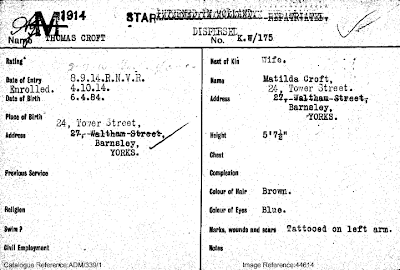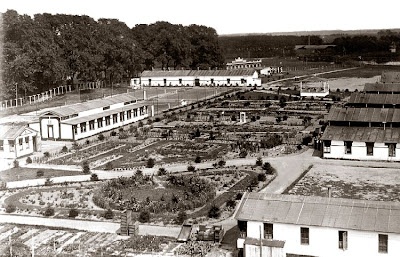Thomas Croft is my OH's great, great uncle. He was born in Lincoln in 1884, the second son of Joseph Croft and his wife Charlotte (maiden name Willerton). Joseph and Charlotte had ten children according to the extra information provided on the 1911 census.
 |
| 1911 census entry for 55 Tower Street, Barnsley (from 1911 census) |
The census return also tells us that of their ten children, two had died prior to this date; one was a baby daughter who died young, the second a teenage girl who died in Barnsley. The four children who are no longer at home with their parents on this census are married and Joseph and Charlotte are grandparents three times over. Three of their married children live within a few hundred yards, a daughter, Alice, on the same street. This suggests to me that the Crofts were a close family.
The children living at home are all working, even fourteen year old William Croft, who is an errand boy for a Fishmonger. The OH's grandfather Joseph Croft is a Trammer (underground), which means he moved the tubs for the coal around the pit.
 |
| 1911 census entry for 18 Smithies Green, Barnsley (from 1911 census) |
In the next few years Thomas and Matilda have two more sons, Lawrence born in 1912 and William born in April 1914. The family have already moved nearer to Thomas's parents, the first address given by Thomas in September 1914 when he joins up is Waltham Street which is just over half a mile away.
 |
| Thomas Croft's Royal Naval Division Record Card (from the National Archives) |
The record card above shows that Thomas Croft joined the Royal Naval Volunteer Reserve in September 1914. He was 5' 7" tall, with brown hair and blue eyes, and he had a tattoo on his left arm.
When the First World War began the Naval reserves of the 1st and 3rd Royal Naval Brigade were called into active service. Mainly made up from soldiers and stokers who used to be in the Royal Navy there were also pre-war volunteers (similar to the Territorial Army) who used to exercise with the Naval officers as a weekend activity. Some men who had volunteered to serve in the Navy at the outbreak of the war, as Thomas did, found themselves in these infantry divisions rather than on a ship. The battalions were named after famous admirals and Thomas joined the 1st Brigade, Benbow Battalion.
The Germans had invaded Belgium on 4 August 1914 and much of the Belgian army and many refugees had packed into the fortified port of Antwerp. Winston Churchill visited Anwerp on 3 October and requested that the Royal Naval Division be sent to Belgium to assist in the defence of this vital supply link to the continent. They were sent on 4 October via Dunkirk to Antwerp. The men were taken by rail to Antwerp and then cheered on by the Belgians, marched to the frontlines on 5 October. Churchill himself admitted they were poorly trained and inadequately equipped.
Meanwhile the British and Belgian armies were falling back in front of the German advance and were retreating onto Antwerp. As the situation became more and more tense it was apparent that there was no choice but to evacuate the army from the city. The only line of retreat was a “dangerous flank march parallel to the Dutch frontier and the sea coast” (Hammerton, 1934). The decision was made to evacuate on 8 October but due to a mix up in communications the 1st Naval Brigade did not receive the order until late in the day and did not start to evacuate until 10pm. Although eight battalions were successfully evacuated by rail to Ostend the men who had set off late did not make the rendezvous. The Ist Brigade had found the roads blocked by civilian refugees and bridges blown up in front of them. They marched for miles making river crossings in small boats and barges. Commander Henderson of the 1st Naval Brigade received reports that the railway had been blown up and that the Germans were advancing towards them. As his men were not in any condition to fight the Germans he decided to cross into neutral Holland rather than be captured.
 |
| The reverse of Thomas Croft's Record Card (from the National Archives) |
On Thomas Croft’s record card it is recorded “8.10.14 Ist Brigade, Benbow Battalion. Interned in Holland”.
It is the next line of the record card that I find fascinating, “19.7.15 Reported at Depot, C.Palace. Escaped”.
I found a short item in the Barnsley Chronicle the “Patriotic Pars” column supporting this.
 |
| Barnsley Chronicle 21 Aug 1915 (from Barnsley Archives) |
The snip is difficult to read as it is a copy from the microfilm of the Barnsley Chronicle in Barnsley Archives, but it says;
“Writing from the Isolation Hospital, Crystal Palace, Thomas Croft asserts that the details he furnished us with regarding his escape from internment in Holland were perfectly true. He adds, “H South, of Benbow Battalion, envies me of my escape because he has not the heart to risk it himself.”
Unfortunately as he was about to discover men who were interned in Holland were not actually supposed to escape - it caused all kinds of problems for the neutral Dutch. According to the record card Thomas was returned to Holland on 8th October 1915. He had been back in England for less than three months. He is recorded as “Run” between the 31st August and the 15th September – did he try to get home? I wonder if he managed to see his family.
 |
| Barnsley Chronicle 22 July 1916 (from Barnsley Archives) |
Another next short piece in the Chronicle in 1916 was the next news of Thomas.
“Thomas Croft, R.M., whose home is at 24, Tower Street, Barnsley, and who was interned in the early stages of the war at Groningen Camp, has been allowed 28 hours leave of absence. Many of his friends will be pleased to hear of this.”
The record card mentions this leave in 1916 as well, and another episode of leave from December 1917 to January 1918.
 |
| Groningen Camp (from the English Camp website) |
There is a lot of information about Groningen Camp, known locally as the English Camp at this website.
The civilian population of the area were initially prepared to give the Englishmen lots of help to escape and 37 actually made it back to England. However in an order issued in January 1915 they were forbidden to aid the escapees any further. The most important of the 20 articles in the order read: “It is forbidden to sell, swap, barter with internees items of civilian clothing, bicycles, horse drawn or motorised vehicles, boats or ice skates.”
Compassionate leave was arranged from the camp for "ill health of next of kin" for example and in 1917 about 350 men received were able to visit home. The British Government guaranteed their return which was initially for one month, but later became two. Eventually this became a regular arrangement whereby all men who had been "well behaved" over the previous four months were allowed to return to England in groups. A new group could not go on leave until the previous one had returned and whilst in England the men were not allowed to do work related to trade or war. As they were a neutral country the Dutch had to come to the same agreement for the German internees they held.
 |
| Barnsley Chronicle 11 May 1918 (from Barnsley Archives) |
This snip from the Barnsley Chronicle in May 1918 shows that the situation in Holland was becoming difficult towards the end of the war. There were food shortages caused by the submarine war and exports of food to Germany. The rations were reduced for the civilians and the internees. Ernest Townend, Ernest Cooper and Tom Croft wrote a letter to the Barnsley Chronicle explaining the situation;
"Here are our daily rations: At eight o'clock in the morning we get one cup of coffee and a quarter of a small dark brown loaf, which runs to three slices, which has to do for your tea as well. Dinner we get some days - a sort of 'pot mess', which consists of potatoes and carrots, no meat. Tea, if you have any bread left from the morning; if not you go without, and I think you will quite agree with me that that is not enough to keep body and soul together".
The men were asking their friends to send them money as they were not allowed parcels and although their wives were doing their best to help them those with several children found it difficult to send anything to their husbands.
On the English Camp website the author notes that, "Questions were asked in the British House of Commons. Queen Wilhelmina of Holland also asked her Minister of War whether the provision of food for the internees really was adequate. The minister advised the Queen that an investigation had revealed that there was no reason for complaint, as the internees received the same quantity of food as the civilian population and '...the quality is as good as can be expected under the circumstances…’ "
There is a note on the bottom of his record card that Thomas' character ranged from Very Good at the end of 1914, to Indifferent a year later; not surprising when you think that he'd made the effort to escape that summer and had been sent back. By December 1916 he is recorded as of Good character and this improves to Very Good by the end of 1917. Was he getting used to the confinement and boredom? Or was it the periods of leave that were cheering him up? That seems likely.
Thomas was allowed to come home for good after the Armistice in November 1918 and was demobilised in February 1919. He and Matilda have another son in September of that year, whom they called Kenneth and a daughter called Mildred three years later.
The family remain at 24 Tower Street for many more years, I've found Thomas and Matilda recorded there in the 1930 Electoral Roll for Barnsley. Thomas dies in 1934 aged fifty and is buried in Barnsley cemetery. When Matilda dies in 1958, she was still living at 24 Tower Street. She was buried in the same grave as Thomas.

5 comments:
Well documented and interesting story. Thomas! Son William married my great auntie Dorothy Ogley.
Thank you for reading 'neve neve', I am glad you found it interesting.
Linda
Could Thomas have married at St. Peter's Barnsley and not Monkbretton?
The banns records on Ancestry are for St Paul's Monk Bretton, which is where the Duttons lived. I can see in my records that in 2007 I looked the marriage up in Barnsley Archives, it was on 25 December 1908 at St Paul's Monk Bretton.
Unfortunately this year is missong from Ancestry.
Thanks,
Linda
Many thanks for confirming this information.
Post a Comment